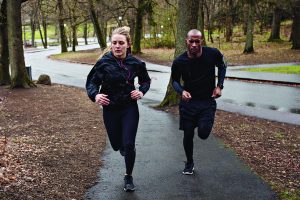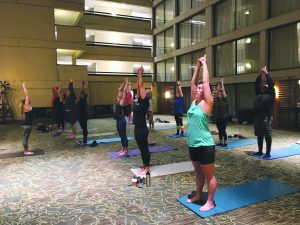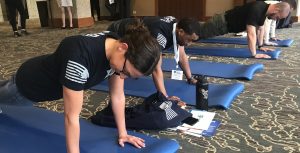Policing is a physically demanding career. While the majority of the daily work within law enforcement does not require enhanced levels of physical fitness, situations can arise where possessing an appropriate level of fitness can be a significant asset for the officer, such as dealing with a noncompliant individual. High fitness levels can enhance officer safety, survivability, and overall health and wellness and facilitate the primary goal of every officer: to go home safe at the end of every shift. Beyond the impact of the current shift, fitness levels can also impact longevity for police officers throughout their careers and into their retirement years.
The Job Requires Fitness
While on duty, officers must be prepared for a wide variety of tasks. Many daily tasks for an officer are predominately sedentary in nature; however, the threat of a volatile situation always exists and requires an officer to constantly be alert.
When a situation requiring escalation in use of force arises, an officer’s fitness—or lack thereof—may impact the level of force utilized. If the officer’s fitness level is not adequate for the task at hand, there is the potential for that lack of fitness to negatively impact the officer’s ability to functionally operate. Additionally, this may elevate the risk of serious bodily injury or death and serve as a factor in a decision to use a higher level of force to effectively stop, control, and neutralize the threat than a fit officer would need to use. That may, in turn, lead to litigation such as what was found in the Parker v. District of Columbia case in 1988.1
In Parker v. District of Columbia, Parker sustained serious injury rendering him a paraplegic after being shot by an officer of the District of Columbia Metropolitan Police Department. As stated in the court briefs, the officer resorted to the use of his gun because he was unable physically to subdue Parker by less drastic means. The case found that the officer’s physical condition was deficient because the District of Columbia was deliberately indifferent to his physical training program; as a result, Parker was awarded a substantial monetary award.
To avoid circumstances such as those in Parker, as well as a focus on use of force throughout the United States, there has been an expanded focus on de-escalation strategies within the policing community. De-escalation often refers to tactically using specific language to achieve a positive outcome. However, de-escalation is not exclusive to verbal interaction. During the initial stages of interaction, before verbal commands even occur, an officer’s command presence may deter crime or diffuse the situation. The offender’s perception of an officer’s fitness may also escalate or de-escalate the situation. Interviews by the FBI have reported that offenders usually size up an officer when making decisions to attack, assault, or murder the officer.2 In circumstances where they feel the officer has the edge, an offender may change their strategy, including the potential of earlier compliance.
Beyond an officer’s presence, empty hand control and less-lethal methods of force all require adequate levels of physical fitness to allow for effective neurological response and kinetic motor movement. The effectiveness of an officer’s ability to grab, hold, deliver impact, and execute other restraining techniques and an officer’s capability for self-defense may depend on the officer’s level of physical fitness.
Heart and Health Issues
When involved in stressful situations, such as dealing with suspect restraints, altercations, or chases, officers face approximately 30 to 70 times increased risk of sudden cardiac death compared to routine, nonemergency functions.3 While stress in combative situations may play a significant factor, it is well documented that higher levels of physical fitness provide significant protection against sudden cardiac death or heart disease, along with other common prevalent health conditions, for law enforcement officers. Many of the other common health conditions in policing are contributing factors for sudden cardiac death. In a 2011 study comparing police officers to the general population, a higher percentage of officers were obese (40.5 percent vs. 32.1 percent), had presence of metabolic syndrome (26.7 percent vs. 18.7 percent), and had elevated mean serum total cholesterol levels (200.8 mg/dL vs. 193.2 mg/dL).4
Furthermore, approximately three-quarters of emergency responders have prehypertension or hypertension, a proportion that is expected to increase based on the obesity epidemic.5 Elevated blood pressure is also often inadequately controlled in these professionals and strongly linked to cardiovascular disease, morbidity, and mortality. The increased prevalence of common morbidities and stress that are widely prevalent in policing contribute to the current mortality rate within law enforcement. Research shows the average life expectancy within law enforcement is 21.9 years less than the average U.S. male.6 Dr. Jon Sheinberg, a cardiologist and law enforcement officer, sets the life expectancy of law enforcement at 57 years, compared to the average U.S. male’s life expectancy of 79.7
Protective Nature of Fitness
Sudden cardiac death, obesity, metabolic syndrome, high cholesterol, and a wide variety of other health risks can be prevented or reduced by improved fitness levels. In one of the largest studies on this topic to date, the Cooper Center Longitudinal Study reported that low-fit males were significantly more likely to die from cardiovascular disease (CVD) than similar but moderately or highly fit males. Low-fit females were even more likely to die from CVD than similar but moderately or highly fit females.8
 Research has shown a protective benefit from a focus on the health-related components of fitness. These include cardiovascular endurance, muscular strength, muscular endurance, flexibility, and body composition. These health-related components of fitness have a strong relationship with overall health and are associated with a lower prevalence of chronic disease, health conditions, and their risk factors.9 Cardiovascular training can help lower blood pressure and increase good (HDL) cholesterol. Strength training can help lower bad (LDL) cholesterol, improve bone health, and improve functional capabilities. A combination of strength and cardiovascular training can help with weight loss and even improve brain health.
Research has shown a protective benefit from a focus on the health-related components of fitness. These include cardiovascular endurance, muscular strength, muscular endurance, flexibility, and body composition. These health-related components of fitness have a strong relationship with overall health and are associated with a lower prevalence of chronic disease, health conditions, and their risk factors.9 Cardiovascular training can help lower blood pressure and increase good (HDL) cholesterol. Strength training can help lower bad (LDL) cholesterol, improve bone health, and improve functional capabilities. A combination of strength and cardiovascular training can help with weight loss and even improve brain health.
For a police officer, it is important to also recognize additional components of fitness specifically related to the essential job tasks based on the bona fide occupational qualifications (BFOQs) of the job. These components include aerobic power, anaerobic power, abdominal strength, agility, and speed. A focus on these additional components is important in meeting the demands of the occupation, especially when there is an escalation of the use of force.
During situations when officers are required to use physical components to stop, control, and neutralize a threat, they will often be required to not only apply strength to effectively use appropriate control tactics—but also perform the maneuver with strength and speed. Combining strength and speed is part of the definition of power and a type of fitness necessary to effectively perform the job. Furthermore, as an officer is stabilizing his or her body and resisting counteractions, a focus on abdominal strength becomes increasingly important.
During events when escalated force is required, the event typically lasts one to two minutes. In the initial stages, the body is without oxygen—that is the definition of anaerobic exercise and is another important component of fitness to maintain.
How to Work on Fitness Components
To improve and maintain these components of fitness, there are specific recommendations for each that should be implemented for safety and effective results. The American College of Sports Medicine recommends that cardiovascular training consist of five days per week of moderate exercise with a total of 30 to 60 minutes per day, or three days per week of vigorous exercise with 20 to 60 minutes per day, or some combination thereof.10
For resistance exercise, it is recommended that each major muscle group should be trained two to three days per week. To build muscular strength 8–12 repetitions are recommended, increasing to 15–25 for muscular endurance.
 In order to enhance flexibility, range-of-motion exercises should be performed two to three days per week for the major muscle tendon units. Each static stretch in which the stretch is held without movement should last for approximately 10–30 seconds during two to four repetitions for maximum benefit.
In order to enhance flexibility, range-of-motion exercises should be performed two to three days per week for the major muscle tendon units. Each static stretch in which the stretch is held without movement should last for approximately 10–30 seconds during two to four repetitions for maximum benefit.
Anaerobic fitness training, meaning “without oxygen,” should be performed through short bouts of intense work. As previously discussed, especially during use-of-force incidents requiring physical hands-on restraint or control tactics, this type of training is very important and potentially life changing. Anaerobic training supplies energy for high-intensity work during incidents lasting less than 60 seconds. When performing this type of training, work is done at a high intensity, thus raising the inherent risk of injury. As a result, anaerobic conditioning should consist only of short intervals of intense work and longer periods of rest and recovery between strenuous workouts. For example, a work-to-rest ratio of one minute of high-intensity exercise with a minimum of a three minutes of rest is utilized by the U.S. Navy in preparing their recruits for battle.11
Strategies for Improvement
When police officers train for these goals, it is important to follow the maxim to “train how you are going to race.” In other words, optimal training consists of understanding the tasks that will likely be demanded of an officer, then optimizing the training session to address the upcoming challenges. In sporting events that focus on short sprints, the majority of training time should be spent with sprint-type training. However, there is still a need to ensure an adequate cardiovascular baseline to provide health benefits and a foundation for sprint training. Similarly, in the policing profession, officers should prepare their bodies for the potential confrontations ahead of them. Even though much of the job is sedentary , the unpredictability and possible conflict situations necessitate elevated fitness levels in the anaerobic, speed, and agility aspects of fitness. The Parker case cited previously emphasizes the importance of adequate levels of physical fitness to allow one to do the job without undue excessive force.
While advanced components of fitness such as anaerobic, speed, and agility are important, it is necessary to remember that any fitness program should begin with the basics. The major focus of an initial program should be on aerobic capacity and muscular strength. The progression to more advanced forms of exercise should take place only after a solid foundation of fitness is achieved. Many fitness programs have been derailed by an overzealous individual or trainer doing too much, too soon. As a result, individuals may suffer an injury that impedes their training and progress.
As officers transition into administration and toward retirement, less emphasis should be placed on anaerobic training and a greater emphasis should be put on aerobic training. While muscular strength, endurance, and flexibility still remain important, the emphasis on aerobic conditioning will help them maintain cardiovascular health and functional capability.
Overcoming Common Barriers
With any program, there will be obstacles and barriers to overcome in order to achieve a successful outcome. Quite often, lack of time is cited as a major reason not to exercise. Based on the normal exercise prescription, many experts agree that 30 minutes per day is the recommended duration of activity. Due to time restraints, limited capability for a long lunch break, and other factors, one single session of 30 minutes or longer could be infeasible for many police officers. However, research has shown that multiple short bouts of exercise of at least 10 minutes can also be as effective as longer bouts in achieving optimal results.12
 Another obstacle may be a lack of access to equipment or gym facilities. However, many forms of aerobic, anaerobic, flexibility, speed, and agility training can be done with little or no extra equipment. Also, with a little creativity, muscle strength and endurance activities can be accomplished with ordinary items. Body weight exercises are an excellent way to increase muscular strength and endurance. Utilizing household and everyday items that provide resistance to the muscles (e.g., water jugs or bottles, books, heavy backpacks) can be as effective as expensive machines and free weights.
Another obstacle may be a lack of access to equipment or gym facilities. However, many forms of aerobic, anaerobic, flexibility, speed, and agility training can be done with little or no extra equipment. Also, with a little creativity, muscle strength and endurance activities can be accomplished with ordinary items. Body weight exercises are an excellent way to increase muscular strength and endurance. Utilizing household and everyday items that provide resistance to the muscles (e.g., water jugs or bottles, books, heavy backpacks) can be as effective as expensive machines and free weights.
There are obstacles to success in any venture. The key for law enforcement is to prioritize the importance of physical fitness. It is crucial to remember that maintaining the most important tool officers have—their bodies—is of paramount importance. As stated in the Presidential Task Force’s 21st Century Recommendations for Policing, “The ‘bulletproof cop’ does not exist… Their wellness and safety are crucial for them, their colleagues, and their agencies, as well as the well-being of the communities they serve.”13
Notes:
1Parker v. District of Columbia, 850 F.2d 708 (1988).
2Anthony J. Pinizzotto, Edward F. Davis, and Charles E. Miller, “The Deadly Mix: Officers, Offenders, and the Circumstances That Bring Them Together,” FBI Law Enforcement Bulletin 76, no. 1 (January 2007).
3Vasileia Varvarigou et al., “Law Enforcement Duties and Sudden Cardiac Death among Police Officers in United States: Case Distribution Study,” BMJ Clinical Research 349 (November 2014).
4Tara A. Hartley et al., “Health Disparities in Police Officers: Comparisons to the U.S. General Population,” International Journal of Emergency Mental Health 13, no. 4 (2011): 211–220.
5Stefanos N. Kales et al., “Blood Pressure in Firefighters, Police Officers, and Other Emergency Responders,” American Journal of Hypertension 22, no. 1 (January 2009): 11–20.
6John M. Violanti et al., “Life Expectancy in Police Officers: A Comparison with the U.S. General Population,” International Journal of Emergency Mental Health and Human Resilience 15, no. 4 (2013): 217–228.
7U.S. Department of Justice, Office of Community Oriented Policing Services, “S1E1: What’s New in Blue Feat. Dr. Jon Sheinberg,” What’s New in Blue, YouTube video, 7:44, December 6, 2018.
8Steven N. Blair et al., “Influences of Cardiorespiratory Fitness and Other Precursors on Cardiovascular Disease and All-Cause Mortality in Men and Women,” JAMA 276, no. 3 (July 1996): 205–210.
9American College of Sports Medicine (ACSM), ACSM’s Guidelines for Exercise Testing and Prescription, 10th ed. (Philadelphia: Wolters Kluwer, 2018).
10Blair et al., “Influences of Influences of Cardiorespiratory Fitness and Other Precursors on Cardiovascular Disease and All-Cause Mortality in Men and Women.”
11Daniel W. Trone, R. Donald Hagan, and Richard A. Shaffer, Physical Training Program Guidelines for U.S. Navy Recruits: Preparing Recruits for Battle Stations, Technical Document 99-1A (San Diego, CA: Naval Health Research Center).
12ACSM, ACSM’s Guidelines for Exercise Testing and Prescription; Robert F. DeBusk et al., “Training Effects of Long Versus Short Bouts of Exercise in Healthy Subjects,” The American Journal of Cardiology 65, no. 15 (1990): 1010–1013.
13President’s Task Force on 21st Century Policing, Final Report of the President’s Task Force on 21st Century Policing (Washington, DC: Office of Community Oriented Policing Services, 2015).
Please cite as
Michael C. Harper and Matthew Wagner, “Enhancing Officer Safety & Survivability,” Police Chief Online, May 19, 2021.



